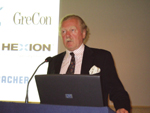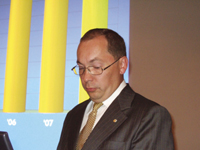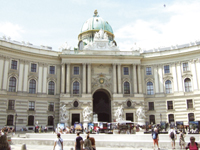Venue in Vienna
6 October 2008The joint Annual General Meetings of the EPF and FEIC are normally held in June. However, this year, due to the fact that the UEFA European Football Championships were partly held in Vienna – meaning no hotel rooms were available in June – the meetings were moved to mid-July.
Whilst the major part of the three-day gathering is taken up with committee meetings of the two organisations, they jointly hold an open meeting at which both presidents summarise the past year and look ahead to the future. There are also presentations from suppliers to the panel industry and, this year, a very interesting presentation by Professor Sten Nielsson, acting director of the IIASA (International Institute for Applied Systems Analysis, Austria) on globalisation/competitiveness of the forest sector.
Ladislaus Döry, president of the EPF, gave the first presentation under the chairmanship of Kris Wijnendaele, secretary general of both EPF and FEIC.
Mr Döry began by announcing an “historicdecision by the EPF to introduce a new standard for low emission board.
This had been approved in principle, with only one member abstaining, during the federation’s general assembly.
In reviewing the European panel industry’s market developments and challenges in 2007, the president reported a turnover for the woodworking industries as a whole of e230bn in the EU-27 countries and a positive year. However, he counselled caution, since the market deteriorated by the end of the year and the first few months of 2008 had been “rather difficult for most [panel] producers”.
Furniture accounted for the largest sub-sector of the woodworking industries by far, at 49%, reported Mr Döry.
In the woodworking industries overall, there were 2.9 million jobs and 380,000 enterprises in the EU-27.
For the panel industry, particleboard accounted for 63% of production, MDF 21% and OSB 6%.
Overall particleboard production grew by 3.5% to almost 37.2 million m3, excluding Russian and Turkish production.
Germany remains at number one in particleboard production rankings, with 8.1 million m3, while Poland took over from France in second place, with 4.5 million m3 in 2007 – 15.8% up on 2006. French production grew by 2.3% to 4.4 million m3, while Italy and Spain decreased their production slightly and held on to fourth and fifth positions.
Lithuania, Slovenia, Estonia, Latvia, Romania and Sweden all showed strong growth rates.
Particleboard capacity expansions for 2008 were listed by Mr Döry in Latvia (+80,000m3), Slovakia (+500,000m3) and Romania (+600,000m3), while Belgium will showed a reduction of 150,000m3.
For MDF in 2007, production excluding Turkey grew by 2.8% to reach 13.3 million m3 in 2007 and this compares with +7.1% average since 1999. Consumption was reported at 12.1 million m3. Growth of 3.5% in production is forecast for 2008.
Three new MDF plants became operational in 2007 said Mr Döry, being one in Poland for Pfleiderer, one in Germany for Classen and one in Hungary for MOFA. However, he pointed out that these only became operational in the second half of the year, so the increase seen in output was mainly due to higher capacity utilisation at the existing plants. Some capacity extensions were also completed in the second half, resulting in average capacity utilisation decreasing to 89%; it was higher in the first half, but demand weakened in the second half.
Germany held on to its leading position again in 2007, increasing its production by 3.7% to almost 4.3 million m3.
Spain added 200,000m3, confirming its second place, and Poland added 250,000m3, both in 2008. At 1.3 million m3, this made Poland Europe’s third biggest producer. France and Italy completed the top five producing countries.
Turkey put in an exceptionally strong performance, registering a production of 1.9 million m3.
Turning his attention to OSB, the president reported that production grew by 7.5% in 2007, while consumption grew by 6%.
Overall production last year rose to 3.7 million m3, with growth largely due to a new mill in Latvia and the Czech plant, built in 2006, coming into full production. Mr Döry reported consumption of 3.0 million m3. Capacity in 2007 was 4.4 million m3, he said. © p18
ß p16 Once again, we find Germany at the top of the producers’ list with its three plants accounting for around 30% of total European production.
There is talk, said Mr Döry, of a further 500,000m3 of OSB production planned for both Latvia and Romania and he questioned what the consequences would be if these projects were to be realised.
Turning to the vexed issue of renewable energy as a tool to combat climate change, the president said: “We [the EPF] are saying that it is better to use wood than to burn it”.
“Nobody has done a proper calculation on the availability of wood for energy production and the EU’s energy objectives in its 20/20 plan will affect our producer members. If those objectives are not met, there will be trouble for the wood industry; or the energy sector….
“The priority must be to get reliable data on current wood use and future availability to serve as a basis for policy making,continued Mr Döry. “The woodworking industry gives value to the forest and respects the carbon cycle.”
Mr Döry went on to outline the EPF’s work in promoting the use of wood and the CEI-Bois Roadmap 2010’s aim to increase the use of wood based products by 4% a year. “It has been estimated this would sequester an additional 150 million tons of CO2 a year,he said.
The president went on to outline a proposed new concept for carbon sequestration credits.
“The cost of wood at the moment is lower than the cost of oil, therefore there is a real threat here,he warned.
Mr Uldis Bikis, retiring president of the FEIC, spoke next. He advised the assembly that Turkey had recently joined his plywood manufacturers’ federation, as had a second producer from the Czech Republic and a Russian producer. Another major Russian producer had also applied for membership at the time of the annual meeting.
“There are 75 plywood producers in 21 countries today. The FEIC member companies had a combined production of 3.9 million m3 of plywood and 0.3 million m3 of blockboard in 2007, while the four member companies in Russia added another 400,000m3 of plywood during 2007,he said.
Italy and Poland produced more plywood last year, while others such as the Czech Republic, France, Greece and Latvia had to reduce their production. Most FEIC member countries saw their production remain fairly stable compared to 2006, reported Mr Bikis.
The largest end-use category for plywood was the construction industry, at 40% share. Furniture was second, at 18%.
“Wood availability continued to be a major issue for the European plywood industry in 2007, with wood costs increasing at a strong pace, and producers in several countries suffered a lack of wood, partly due to climatic problems. In northern Europe, harvests were again complicated by the warm winter, while other countries suffered increasing competition for wood.
“On top of this, Russia started imposing export duties on logs from July 2007. These duties are increasing and are scheduled to amount to e50 per m3 from January 2009,said the FEIC president.
“FEIC, in cooperation with the European Confederation of Woodworking Industries (CEI-Bois), managed to convince the European Commission at the highest political level to take up this very important issue with the Russian authorities to attempt to create equal opportunities for all market players,says the plywood federation’s Annual Report.
Plywood imports in FEIC member countries in 2007 increased by 6.1% to more than four million m3 and by 5.7% in the EU-27, reported Mr Bikis.
“Thus the EU-27 imported 5.5 million m3, meaning that extra-European imports have been accelerating at a much higher pace than intra-European trade. Chinese imports registered the strongest growth rates, at plus 38% or 1.3 million m3, making China the EU’s biggest foreign plywood supplier, while Russia has gone from first to third position.”
Mr Bikis reported an unhappy state of affairs as exports decreased for the first time in years.
Exports of FEIC members fell 3.4%, while for the EU-27 they fell 6.3%, reported the president.
“Also, unfair competition continues despite the anti-dumping regulations,he added.
“Plywood consumption in 2007 started in a promising way, but was then increasingly affected by the economic situation. “However, within the FEIC member countries, consumption of plywood gained 10.8%, increasing for the sixth consecutive year.”
In his published annual report to his members, Mr Bikis said: “Our industry is facing several serious challenges for the future, particularly in the cost and raw material supply side of our businesses.
“Ensuring a sustainable raw material supply of high quality at affordable cost is everybody’s top priority even though there are huge regional differences in the reasons for supply tightness.
“The second big issue is energy cost and other side-effects of the oil price hike.
“Thirdly and very importantly, the developments in Russia may have tremendous consequences for our industry. There are many questions relating to Russia: what will be its strategy for oil and gas exports and how will this affect the economies in Europe and the rest of the world? What will be the effects of the export taxes on the supply of Russian logs to Europe and to China? Will this result in more exports of semi-finished wood products to Europe on the one hand and increasing costs and reduced log supply to China on the other?
To monitor and steer these and other huge future challenges, I am convinced that we need an even stronger European federation”. n
For further information on EPF and FEIC or to purchase copies of their annual reports, contact the joint secretariat at: info@europanels.org or www.europanels.org



